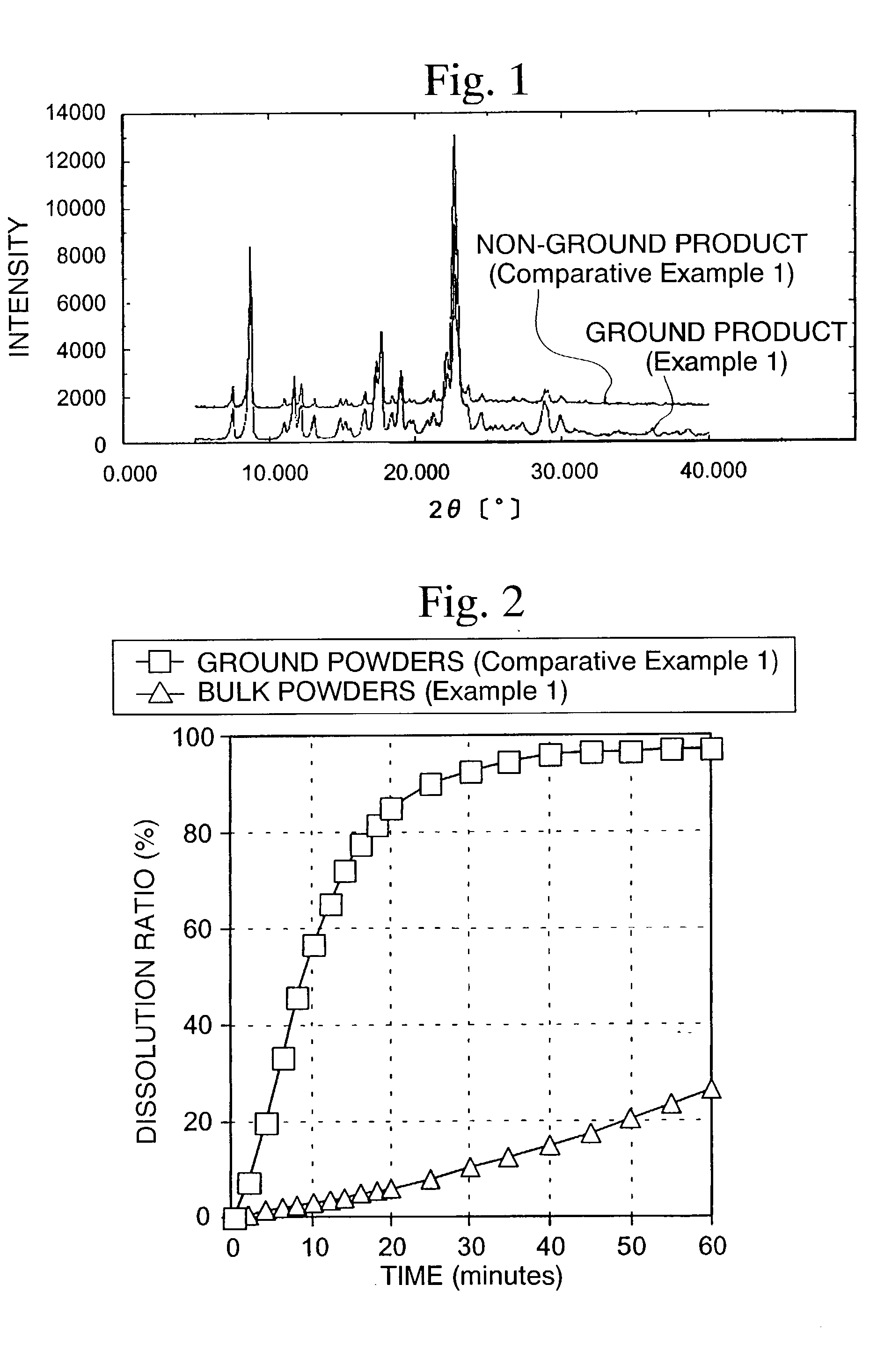Quinolinone derivative pharmaceutical compositon and production method therefor
a technology of quinolinone and compositon, which is applied in the direction of drug composition, immunodeficiency, biocide, etc., can solve the problems of inability to meet the requirements of the patient, the absorption ratio and the absorption rate are likely to change, and the dissolution rate of the pharmaceutical preparation produced by the method described is not always satisfactory, so as to achieve the effect of fast dissolution of an active ingredient in the digestive tract and superior long-term storage stability
- Summary
- Abstract
- Description
- Claims
- Application Information
AI Technical Summary
Benefits of technology
Problems solved by technology
Method used
Image
Examples
examples
[0057]The present invention will be described in more detail by way of Examples and Comparative Examples; however, the following Examples are not to be construed to limit the scope of the present invention.
[0058]Hereinafter “%” means “% by weight”, unless otherwise specified.
preparation example
[0059]According to the method described in Example 38 of Japanese Unexamined Patent Application, First Publication No. Hei 9-255659, 7-(3,5-dimethoxy-4-hydroxycinnamoylamino)-3-octyloxy-4-hydroxy-1-methyl-2(1H)-quinoline represented by the structural formula (I) (hereinafter referred merely to as a quinolinone derivative) was synthesized and, furthermore, a quinolinone derivative was obtained as a β-type crystal according to the method described in Reference Example 2 of Japanese Unexamined Patent Application, First Publication No. Hei 11-255649.
[0060]The method described above was conducted two or more times to obtain quinoline before grinding (hereinafter referred to as a quinolinone derivative (A) and a quinolinone derivative (B)).
[0061]The particle size distribution of the quinolinone derivative (A) was measured and differential scanning calorimetry (DCS) was conducted. As a result, the average particle diameter was 25.3 μm and particles having a particle diameter of 15 μm or le...
examples 7 to 11
[0081]According to the formulation shown in Table 3, a quinolinone derivative (A-1, ground product), lactose, crystalline cellulose and L-HPC were mixed in a mortar. An aqueous solution of HPC-L prepared by previously dissolving in a proper amount of water was added to the above composition so that the amount becomes 4 parts by weight (Example 7), 6 parts by weight (Example 8), 8 parts by weight (Example 9), 10 parts by weight (Example 10) and 12 parts by weight (Example 11) based on 100 parts by weight of the quinolinone derivative. The mixture was kneaded, classified using a No. 20 screen and then dried. After drying and classifying using screen No. 35, quinolinone derivative granules were obtained. The resulting quinolinone derivative granules were mixed with 0.5% magnesium stearate, and then 200 mg of the mixed powders were hydrostatically compressed under a pressure of 600 kg by a hydraulic press using a punch having a diameter of 8 mm and double R to obtain tablets.
[0082]
TABLE...
PUM
| Property | Measurement | Unit |
|---|---|---|
| fusion enthalpy | aaaaa | aaaaa |
| particle diameter | aaaaa | aaaaa |
| particle size distribution | aaaaa | aaaaa |
Abstract
Description
Claims
Application Information
 Login to View More
Login to View More - R&D
- Intellectual Property
- Life Sciences
- Materials
- Tech Scout
- Unparalleled Data Quality
- Higher Quality Content
- 60% Fewer Hallucinations
Browse by: Latest US Patents, China's latest patents, Technical Efficacy Thesaurus, Application Domain, Technology Topic, Popular Technical Reports.
© 2025 PatSnap. All rights reserved.Legal|Privacy policy|Modern Slavery Act Transparency Statement|Sitemap|About US| Contact US: help@patsnap.com



